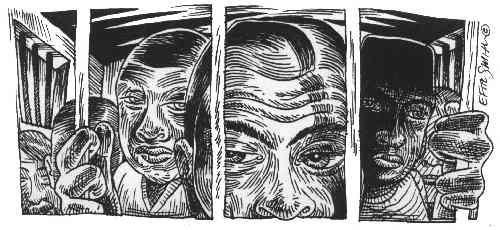

Before we declare all criminals enemies of the people and rush to build more cells and higher walls to lock them away, let's consider what we're really doing.
As Congress and state lawmakers rushed to pass "get tough" crime legislation to satisfy over 90 percent of their constituents (according to recent polls), the promise was that offenders would spend more time in prison with less chance of early supervised release all in the name of public protection.
At federal and state levels money for increased prison construction and operation will come at the expense of crime prevention, education, health care, family assistance and other social needs. The best-case scenario is that current criminals will be removed from the streets and would-be offenders will be deterred from committing crimes.
Unfortunately, that scenario is fundamentally flawed. The more people we imprison, the more entrenched the crime problem becomes.
When the Quakers invented incarceration as punishment for crime, they thought it would lead sinners to repent (penitentiaries) and reform (reformatories). Instead, inmates at first went insane in their dark, lonely cells and, later, as conditions ameliorated, they simply became angry and hostile. Imprisonment to punish and deter was a dismal failure.
Then, for a short time, some states attempted "corrections" or "rehabilitation." While some programs worked well in places, by the mid-1970s this model was mostly abandoned and warehousing began, despite the fact pointed out eloquently by former prison warden and corrections administrator Ellis McDougall "rehabilitation has never really been tried."
If toughness worked, the United States would have little, if any, crime because as recent studies show the United States has the longest prison terms for the most offenses of any nation, while remaining the crime capital of the world.
Imprisonment may punish people, but it also dehumanizes them, making them hard. Institutions become schools for crime, producing individuals who have lost any ability or inclination to live within society's rules.
In reality, the more people we imprison, the more hardened criminals we'll have in the long run, as most of the "vicious" criminals started as minor offenders who were transformed by juvenile and adult prison experiences into violent habitual offenders.
Beyond this, the premise of the war on crime is flawed, as it results from scare tactics and demagoguery promoted by a conflict-driven news media which influences the public and our elected officials.
Most law violators are not the raving homicidal maniacs, psychopathic child molesters or lurking rapists painted by the media; those offenses represent only about one percent of crime in America.
Plenty of space in prison already exists for this small group of violent offenders, along with career burglars. The average street criminal has committed a petty theft offense and is in his or her teens or early 20s.
Long-term research indicates that 90 percent of high school seniors admit to crimes, including vandalism, breaking and entering, assault and arson, that would carry time in prison if the law were strictly enforced. The average offender could be your son or daughter or the teenager next door.
Most violators are never charged with their crimes. In fact, we catch so few violators that "get tough" policies neither incapacitate most offenders nor deter any rational potential offender.
Finally, research clearly indicates we human beings do what we do to gain rewards, with attention being at the top of the list. We change our behavior because no reward, especially attention, is forthcoming. In the current criminal justice system, we reward bad behavior with attention, while ignoring good behavior.
In other words, we give attention to the attention-starved only when they violate the law. Until we reverse this, there is no real hope for change. The reactive approach to crime, based on the assumption that it's a mean world, will never result in creating a safe society.
The only effective approach is based on prevention. This requires a massive infusion of community building and community service. First we must build real communities, where people know and talk to one another; and there must be mutual concern, giving care and attention to everyone's needs, with special emphasis on communal concerns and care of children.
The justice system must also change its focus, from warring on crime to bringing peace to the 'hood. The framework for such a change is already developing in such approaches as community-oriented policing, mediating juvenile and adult conflicts, and community-based prevention and correctional programs.
Success will be measured by crimes not committed because the community, in partnership with justice and social service agencies, identifies crime-breeding situations early and deals with them before the crimes occur. Having to arrest and imprison a person would come to be seen as a personal and systemic failure.
The transition is possible, but only if we are willing to give up our love affair with the war model and the illusion that meeting violence with violence, harm with harm, is an effective way to create a safe community.
In the final analysis, current proposals take money away from lower-cost, highly effective prevention programs and use many more dollars to build expensive, ineffective institutions that will bankrupt us economically, socially and morally. We would be wise to rethink our priorities.
Gene Stephens teaches in the College of Criminal Justice at the University of South Carolina. This essay is provided by Forum, a non-profit educational organization.

© Copyright by POINT, 1995
Last modified 8/8/95